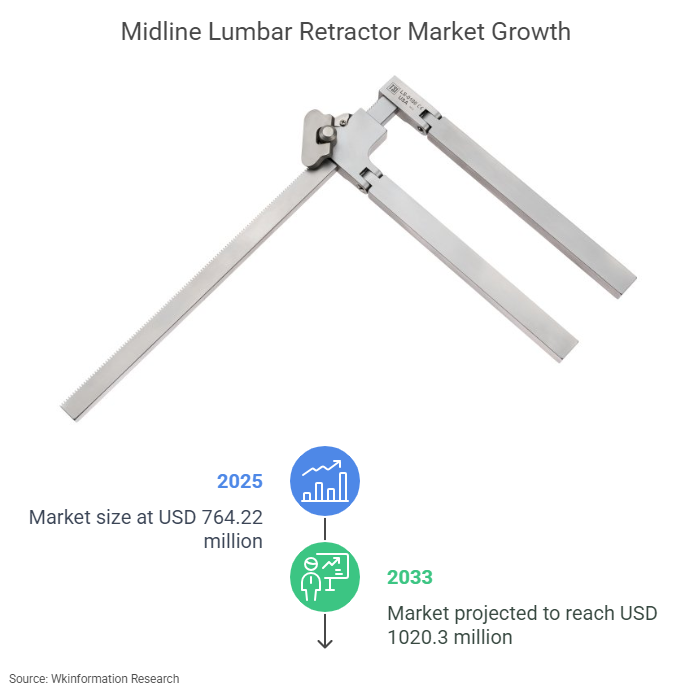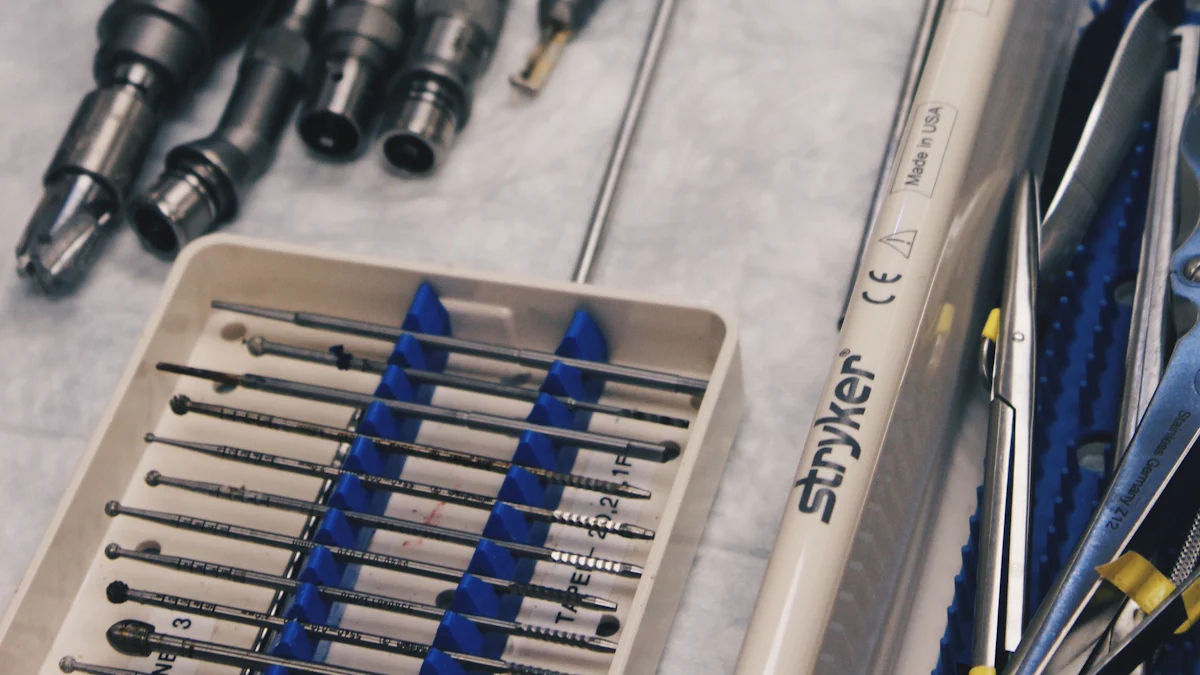
Midline lumbar retractors play a pivotal role in spinal surgeries by providing surgeons with clear access to the operative site while minimizing tissue damage. Their significance has grown as the demand for minimally invasive procedures continues to rise. For instance, the spinal surgery devices market is projected to grow from USD 764.22 million in 2025 to USD 1020.3 million by 2033, driven by advancements in surgical techniques and the increasing prevalence of spinal disorders. Technological advancements, such as AI-driven precision tools and customizable retractor systems, have further enhanced surgical efficiency and patient outcomes, transforming the midline lumbar retractor market.
Key Insights
- Midline lumbar retractors help in spine surgeries by reducing harm.
- More people want less invasive surgeries, so the market is growing.
- New tech like smart tools and better designs make surgeries easier.
- High prices and strict rules slow growth, needing teamwork to fix.
- Asia-Pacific is becoming important due to better hospitals and awareness.

Market Overview

Key Trends Shaping the Midline Lumbar Retractor Market
Several trends are influencing the midline lumbar retractor market:
- Increasing demand for minimally invasive surgical techniques.
- Technological advancements in surgical tools and retractor designs.
- Rising prevalence of spinal disorders, leading to a higher number of spinal surgeries.
- Development of innovative retraction tools to enhance surgical efficiency and patient outcomes.
These trends underscore the importance of innovation in meeting the evolving needs of healthcare professionals and patients. The integration of cutting-edge technologies, such as AI and robotics, is expected to further revolutionize the market.
Importance of Midline Lumbar Retractors in Modern Medicine
Midline lumbar retractors play a critical role in modern spinal surgery. They improve surgical precision and provide better access to the operative site. Their design facilitates minimally invasive procedures, which are increasingly preferred due to reduced recovery times and lower risks.
Advancements in materials and mechanisms have enhanced their functionality, offering better visualization and minimizing tissue trauma. The growing incidence of spinal disorders has amplified the demand for these tools, as healthcare professionals prioritize patient outcomes and surgical efficiency. Midline lumbar retractors have become indispensable in procedures like spinal decompression and fusion surgeries, solidifying their role in modern medicine.
Market Drivers and Challenges
Technological Advancements in Retractor Design
Technological advancements are revolutionizing the midline lumbar retractor market. Innovations in materials, such as lightweight titanium and stainless steel, have improved durability and cleanliness. Ergonomic designs now reduce surgeon fatigue, enhancing precision during surgical procedures. Specialized retractors tailored for specific surgeries, including cardiovascular and orthopedic applications, are gaining traction. Additionally, minimally invasive surgical retractors designed for small incisions optimize visualization and reduce tissue disruption. Wireless retractors with remote control capabilities are also emerging, particularly in robotic-assisted surgeries. These advancements are driving market growth by addressing the evolving needs of healthcare professionals and improving patient outcomes.
Rising Prevalence of Spinal Disorders
The global rise in spinal disorders is significantly impacting the demand for midline lumbar retractors. Conditions such as herniated discs and spinal stenosis are becoming increasingly common, leading to a surge in spinal surgeries. This trend underscores the importance of advanced surgical tools that enhance precision and efficiency. Healthcare professionals are prioritizing tools that minimize tissue damage and improve recovery times. The growing prevalence of spinal disorders highlights the critical role of midline lumbar retractors in modern medicine, as they enable surgeons to perform complex procedures with greater accuracy.
Growing Demand for Minimally Invasive Surgeries
The demand for minimally invasive surgeries continues to grow, driven by several factors. An aging population increasingly opts for these procedures due to their reduced recovery times and lower risks. Technological advancements in spinal surgery have further fueled this demand, enabling more precise and effective interventions. The rising incidence of obesity and degenerative spinal conditions has also contributed to the popularity of minimally invasive surgeries. These procedures require advanced tools like midline lumbar retractors, which facilitate small incisions and minimize tissue disruption. As a result, the market for these retractors is expanding, reflecting the broader shift toward less invasive surgical techniques.
Challenges: High Costs and Regulatory Hurdles
The midline lumbar retractor market faces significant challenges that hinder its growth and accessibility. High costs associated with retractor systems remain a primary concern for manufacturers and healthcare providers. Advanced materials like titanium and stainless steel, combined with precision engineering, drive up production expenses. These costs often translate into higher prices for end-users, limiting adoption in cost-sensitive regions and smaller healthcare facilities.
Stringent regulatory approvals further complicate market dynamics. Manufacturers must navigate complex and time-consuming processes to ensure compliance with safety and quality standards. Regulatory bodies, such as the FDA in the United States and the EMA in Europe, impose rigorous testing and documentation requirements. While these measures protect patient safety, they also increase development timelines and costs. Smaller companies, in particular, struggle to meet these demands, creating barriers to entry and stifling innovation.
Intense competition from established players adds another layer of difficulty. Dominant companies with extensive resources and established distribution networks often overshadow emerging manufacturers. This competitive landscape forces smaller firms to invest heavily in marketing and innovation to differentiate their products. However, these investments further strain financial resources, making it challenging to achieve profitability.
The combination of high costs, regulatory hurdles, and competitive pressures creates a challenging environment for market participants. Addressing these issues requires collaborative efforts between manufacturers, regulatory agencies, and healthcare providers. Streamlining approval processes and exploring cost-effective production methods could help alleviate these challenges. By overcoming these obstacles, the midline lumbar retractor market can expand its reach and better serve the growing demand for advanced surgical tools.
Market Segmentation Analysis
By Material Type
Stainless Steel
Stainless steel remains a popular choice for midline lumbar retractors due to its strength, durability, and affordability. It offers excellent resistance to wear and tear, making it suitable for repeated use in surgical settings. However, its heavier weight compared to other materials can pose challenges during lengthy procedures.
Titanium
Titanium has gained significant traction due to its superior strength-to-weight ratio and excellent biocompatibility. Its corrosion resistance ensures longevity, even in demanding surgical environments. These attributes make titanium retractors ideal for minimally invasive surgeries, where precision and reduced strain on surgeons are critical.
Polymeric Materials
Polymeric materials, such as Polyetheretherketone (PEEK), are lightweight and offer high strength and chemical resistance. Their radiolucency allows for better visualization during imaging procedures, enhancing surgical accuracy.
By Mechanism
Manual Retractors
Manual retractors require continuous support from the surgical team, making them less efficient for prolonged procedures. Their simplicity and affordability make them suitable for smaller healthcare facilities. However, their limitations in ergonomics and efficiency have led to a gradual decline in demand, especially as surgical techniques evolve.
Self-Retaining Retractors
Self-retaining retractors eliminate the need for manual support by holding tissues in place during surgery. This design reduces surgeon fatigue and enhances focus, leading to improved surgical outcomes. Their popularity has surged with the rise of minimally invasive surgeries, where precision and efficiency are paramount. The market for self-retaining retractors continues to grow, driven by advancements in surgical tools and techniques.
By Blade Design
Fixed Blades
Fixed blade retractors provide stability and are commonly used in procedures requiring consistent retraction. Their straightforward design ensures reliability, making them a staple in many surgical settings. However, their lack of adjustability can limit their versatility in complex surgeries.
Adjustable Blades
Adjustable blade retractors offer greater flexibility, allowing surgeons to modify the blade position based on the surgical requirements. This adaptability enhances their utility in diverse procedures, particularly in minimally invasive surgeries. Their growing adoption reflects the increasing demand for versatile and customizable surgical tools.
By Application
Spinal Decompression Surgeries
Spinal decompression surgeries aim to relieve pressure on the spinal cord or nerves caused by conditions like herniated discs or spinal stenosis. Midline lumbar retractors play a crucial role in these procedures by providing surgeons with clear access to the affected area while minimizing tissue damage. Their precision and adaptability make them indispensable in achieving optimal surgical outcomes. Hospitals, ambulatory surgical centers (ASCs), and specialty clinics frequently utilize these retractors to enhance surgical efficiency and improve patient recovery times.
Spinal Fusion Procedures
Spinal fusion procedures involve joining two or more vertebrae to stabilize the spine and alleviate pain caused by spinal disorders. Midline lumbar retractors facilitate these surgeries by ensuring proper visualization and access to the surgical site. Their ergonomic designs reduce surgeon fatigue during these often lengthy procedures. ASCs and specialty clinics increasingly adopt these retractors due to their ability to support minimally invasive techniques, which are preferred for their shorter recovery periods and reduced risks.
Tumor Resection Procedures
Tumor resection procedures in the spine require precision and careful handling of surrounding tissues. Midline lumbar retractors assist surgeons in accessing and removing spinal tumors with minimal disruption to healthy tissue. Their advanced blade designs and material options, such as titanium and polymeric materials, enhance surgical accuracy. Specialty clinics and hospitals rely on these retractors to perform complex tumor resections, ensuring better patient outcomes and reduced postoperative complications.
By Region
North America
North America leads the midline lumbar retractor market, driven by its advanced healthcare system and high spending in healthcare. The region’s increasing spinal disorder rates and growing preference for minimally invasive surgeries support market growth. The market is expected to maintain strong growth over the coming years.
Europe
Europe holds a significant market share, backed by its established healthcare infrastructure and a high incidence of spinal disorders. The region benefits from innovations in surgical techniques and a focus on enhancing patient outcomes, contributing to steady market expansion.
Asia-Pacific
Asia-Pacific is experiencing rapid market growth, fueled by improvements in healthcare and rising awareness of spinal health. The aging population and investments in healthcare infrastructure continue to drive demand for midline lumbar retractors, positioning the region as an important market player.
Latin America
Latin America shows moderate growth in the midline lumbar retractor market. Improving healthcare infrastructure and increasing access to advanced surgical tools contribute to this trend. The region’s focus on enhancing spinal care and addressing the rising incidence of spinal disorders supports market expansion.
Middle East & Africa
The Middle East & Africa region experiences gradual growth, driven by investments in healthcare infrastructure and rising awareness of spinal health. Although the market share remains smaller compared to other regions, the adoption of minimally invasive surgeries and advanced surgical tools is steadily increasing.
Competitive Landscape
Key Players in the Midline Lumbar Retractor Market
Overview of Major Companies
Several prominent companies dominate the midline lumbar retractor market by offering innovative solutions tailored to modern surgical needs.
- Medtronic: Renowned for its advanced midline lumbar retractors designed to enhance surgical precision and outcomes.
- Stryker Corporation: A leader in innovative surgical tools, including retractors that support minimally invasive procedures.
- Zimmer Biomet: Provides a comprehensive range of instruments for spinal surgeries, ensuring reliability and efficiency.
Other notable players include DePuy Synthes, Johnson & Johnson, Globus Medical, and TeDan Surgical Innovations. These companies maintain a strong presence through continuous product development and strategic market positioning.
Strategies for Market Penetration
Major companies employ diverse strategies to strengthen their foothold in the midline lumbar retractor market.
- Product innovation remains a key focus, with companies enhancing retractor designs to improve surgical efficiency and patient outcomes.
- Strategic partnerships, mergers, and acquisitions enable firms to expand their product portfolios and market reach.
- Market expansion efforts target emerging regions, leveraging the growing demand for advanced surgical tools.
These strategies ensure sustained growth and competitiveness in a rapidly evolving market.
Emerging Players and Innovations
Emerging players are reshaping the market with groundbreaking innovations. Adjustable retractors, for instance, offer enhanced surgical precision and minimize tissue damage. These advancements align with the increasing demand for minimally invasive surgeries, reflecting a shift toward patient-centric solutions. By addressing specific surgical challenges, these players contribute to the market’s dynamic evolution.
Mergers, Acquisitions, and Partnerships
Collaborative activities such as mergers, acquisitions, and partnerships play a pivotal role in shaping the competitive landscape. Companies leverage these initiatives to consolidate their market position, access new technologies, and expand their global presence. For example, partnerships between established firms and emerging innovators foster the development of cutting-edge surgical tools. These collaborations not only drive innovation but also enhance the accessibility of advanced retractors across diverse healthcare settings.
Recent Industry Developments

Innovations in Retractor Technology
The midline lumbar retractor market has experienced remarkable technological advancements in recent years. Adjustable retractors have gained popularity due to their versatility and ability to meet the growing demand for minimally invasive surgeries. These retractors allow surgeons to modify blade positions, enhancing adaptability during complex surgical procedures. Fixed retractors, while less flexible, remain essential for their stability and reliability in specific operations.
Advancements in materials technology have led to the creation of retractors with improved strength, durability, and radiolucency. These innovations enhance surgical outcomes by providing better visualization and reducing tissue trauma.
Manufacturers have also introduced retractors with smaller profiles and enhanced visualization capabilities. These designs aim to minimize surgical trauma and improve patient recovery times. By focusing on ergonomic designs and lightweight materials, companies are addressing the need for tools that reduce surgeon fatigue and improve surgical precision.
Market Growth Factors
Several factors contribute to the market growth of midline lumbar retractors. The rising prevalence of spinal disorders has increased the demand for advanced surgical tools. Patients and healthcare providers increasingly prefer minimally invasive surgeries due to their shorter recovery times and lower risks. This preference has driven the adoption of retractors designed specifically for such procedures.
Technological advancements continue to play a pivotal role in shaping the market. Innovations in materials and design have improved the functionality and efficiency of retractors, making them indispensable in modern surgical procedures. Additionally, the growing awareness of patient safety has encouraged the development of tools that minimize tissue damage and enhance surgical outcomes.
Regulatory Approvals and Their Impact
Regulatory approvals significantly influence the development and adoption of midline lumbar retractors. Government health authorities impose stringent requirements for medical devices, ensuring compliance with safety and quality standards. These regulations, while essential for patient safety, often pose challenges for manufacturers. The approval and clearance processes can be time-consuming and costly, affecting the pace of innovation.
Manufacturers must navigate complex regulatory landscapes to bring new products to market. This challenge is particularly pronounced for smaller companies with limited resources. Despite these hurdles, regulatory compliance remains a critical factor in gaining the trust of healthcare providers and ensuring widespread adoption of advanced retractor systems.
Overview
The midline lumbar retractor market continues to evolve, driven by rising demand for minimally invasive surgeries and advancements in surgical technologies. Key trends include the increasing number of spinal surgeries globally and the push for precision tools that enhance reliability. However, challenges such as pricing pressures and regulatory hurdles persist. Technological innovations, including AI-driven systems and automation, are reshaping the industry by improving surgical outcomes and streamlining manufacturing. Emerging economies with expanding healthcare infrastructure present significant growth opportunities. Strategic investments in R&D and partnerships will remain critical for fostering innovation and addressing market demands effectively.
| Report Metric | Details |
|---|---|
| Report Name | Global Midline Lumbar Retractor Market Report |
| Base Year | 2024 |
| Segment by Type |
· Stainless Steel · Titanium · Polymeric Materials |
| Segment by Application |
· Spinal Decompression Surgeries · Spinal Fusion Procedures · Tumor Resection Procedures |
| Geographies Covered |
· North America (United States, Canada) · Europe (Germany, France, UK, Italy, Russia) · Asia-Pacific (China, Japan, South Korea, Taiwan) · Southeast Asia (India) · Latin America (Mexico, Brazil) |
| Forecast units | USD million in value |
| Report coverage | Revenue and volume forecast, company share, competitive landscape, growth factors and trends |
FAQ
What are midline lumbar retractors used for?
Midline lumbar retractors provide surgeons with clear access to the spine during procedures. They minimize tissue damage, improve visualization, and enhance surgical precision. These tools are essential for spinal decompression, fusion, and tumor resection surgeries.
Why is titanium preferred for midline lumbar retractors?
Titanium offers a superior strength-to-weight ratio, excellent biocompatibility, and corrosion resistance. These properties make it ideal for minimally invasive surgeries, where precision and reduced strain on surgeons are critical.
How do self-retaining retractors differ from manual retractors?
Self-retaining retractors hold tissues in place without manual support, reducing surgeon fatigue and improving focus. Manual retractors require continuous assistance, making them less efficient for lengthy or complex procedures.
What challenges does the midline lumbar retractor market face?
The market faces high production costs, stringent regulatory requirements, and intense competition. These factors limit accessibility, especially in cost-sensitive regions, and create barriers for smaller manufacturers.
Which regions show the highest growth potential for this market?
Asia-Pacific demonstrates the highest growth potential due to its expanding healthcare infrastructure, increasing awareness of spinal health, and rising elderly population.
Global Midline Lumbar Retractor Market Report (Can Read by Free sample) – Table of Contents
Chapter 1: Midline Lumbar Retractor Market Analysis Overview
- Competitive Forces Analysis (Porter’s Five Forces)
- Strategic Growth Assessment (Ansoff Matrix)
- Industry Value Chain Insights
- Regional Trends and Key Market Drivers
- Midline Lumbar Retractor Market Segmentation Overview
Chapter 2: Competitive Landscape
- Global Midline Lumbar Retractorplayers and Regional Insights
- Key Players and Market Share Analysis
- Sales Trends of Leading Companies
- Year-on-Year Performance Insights
- Competitive Strategies and Market Positioning
- Key Differentiators and Strategic Moves
Chapter 3: Midline Lumbar Retractor Market Segmentation Analysis
- Key Data and Visual Insights
- Trends, Growth Rates, and Drivers
- Segment Dynamics and Insights
- Detailed Market Analysis by Segment
Chapter 4: Regional Market Performance
- Consumer Trends by Region
- Historical Data and Growth Forecasts
- Regional Growth Factors
- Economic, Demographic, and Technological Impacts
- Challenges and Opportunities in Key Regions
- Regional Trends and Market Shifts
- Key Cities and High-Demand Areas
Chapter 5: Midline Lumbar Retractor Emerging and Untapped Markets
- Growth Potential in Secondary Regions
- Trends, Challenges, and Opportunities
Chapter 6: Product and Application Segmentation
- Product Types and Innovation Trends
- Application-Based Market Insights
Chapter 7: Midline Lumbar Retractor Consumer Insights
- Demographics and Buying Behaviors
- Target Audience Profiles
Chapter 8: Key Findings and Recommendations
- Summary of Midline Lumbar Retractor Market Insights
- Actionable Recommendations for Stakeholders


